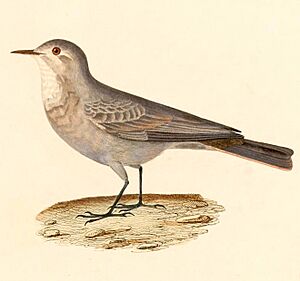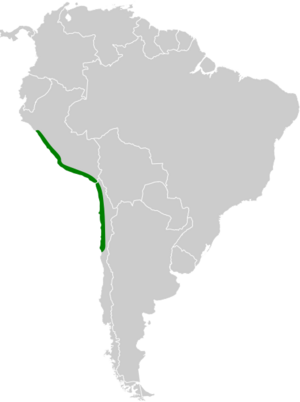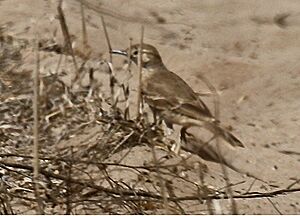Greyish miner facts for kids
Quick facts for kids Greyish miner |
|
|---|---|
 |
|
| Conservation status | |
| Scientific classification | |
| Genus: |
Geositta
|
| Species: |
maritima
|
 |
|
The greyish miner (Geositta maritima) is a small bird that lives along the coasts of Chile and Peru. It belongs to the ovenbird family called Furnariidae. These birds are often called "miners" because they like to dig burrows in the ground, similar to how miners dig for minerals!
Contents
About the Greyish Miner
The greyish miner is a unique bird. It is the only species in its group, meaning it doesn't have any close relatives that are also called "miners" within its specific genus.
What Does It Look Like?
The greyish miner is a small bird, usually about 12 to 15 centimeters (around 5 to 6 inches) long. It weighs about 16 to 17 grams, which is roughly the weight of a few quarters. Both male and female greyish miners look very similar.
They have a pale gray-brown face with a light, creamy stripe above their eye. Their back and upper parts are also pale gray-brown. The middle feathers of their tail are gray-brown, but the other tail feathers are black with white edges on the very outside ones. Their wings are gray-brown with wide sandy-brown edges, and their flight feathers are a dark brown.
Underneath, their chin and throat are white. The rest of their belly is creamy white, with a pinkish-buff color on their sides. They have brown eyes, and their short, straight beak, legs, and feet are dark gray to black. Young greyish miners look a lot like the adults but have a bit more of a buff (light yellowish-brown) color overall.
Where Do They Live?
The greyish miner mostly lives near the coast, though sometimes it can be found a little bit inland on the flat coastal areas. It lives in a narrow strip of land from Peru's Department of Ancash all the way south to Chile's Atacama Region.
Their home is often described as "desolate," which means it's a very dry and empty place. It's usually made of sand, gravel, and rocks, with hardly any plants growing there. They usually live below 2,450 meters (about 8,000 feet) in elevation, but sometimes they can be found as high as 3,500 meters (about 11,500 feet) in Peru. In Chile, they live between 500 and 2,800 meters (about 1,600 to 9,200 feet) high.
How Do They Behave?
Movement and Travel
The greyish miner does not migrate. This means they stay in the same area all year round and do not travel long distances for different seasons.
What Do They Eat?
We don't know a lot of details about how the greyish miner finds its food or exactly what it eats. We do know that they search for food on the ground. They are usually seen alone or in pairs. Scientists have found seeds and insects in the stomachs of some greyish miners, so we know those are part of their diet.
Reproduction and Life Cycle
Very little is known about how the greyish miner raises its young. Only one nest has ever been found, and it wasn't described in much detail. Scientists believe they probably nest in a burrow with a small chamber at the end, just like other birds in their genus.
What Sounds Do They Make?
The greyish miner has a song that sounds like an "unmusical te-cherrrr." Sometimes, this is followed by a longer series of notes like "ke ke ke ke ...." They also make different calls, such as "plyt-plyt", "jyp", a rough "tch-trr", and a short, somewhat squeaky "kew."
Is the Greyish Miner Safe?
The IUCN (International Union for Conservation of Nature) has decided that the greyish miner is a species of "Least Concern." This means they are not currently in danger of disappearing. They live across a fairly large area, and even though we don't know exactly how many there are, their population seems to be stable.
No immediate threats to the greyish miner have been found. Some people describe them as uncommon, while others say they are common in certain places. Human activities probably don't affect the greyish miner much because they live in very dry, empty areas where not many people live.



